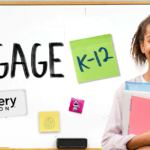By John Harrington | Originally published in the June/July 2020 issue of AC&E/Equity & Access
There is a growing gap between students who have access to a fast Internet connection and those who do not. This gap is sometimes referred to as the Digital Divide. More recently, the term “homework gap” has been used. But no matter how you refer to it, for students who lack the necessary resources, the inability to get online is a barrier to their success. Like access to running water and electricity, Internet access plays a vital role in providing students a quality education. It is time for our society to address digital equity by ensuring that every learner is online. Not all learning is online, but every learner should be.
No Internet Access After School
Funds For Learning estimates that there are 7.2 million family households in the United States who are not online — millions of Americans who lack and cannot afford Internet access at home. For students, this means an inability to complete homework assignments, collaborate with their peers, review materials from their teacher, or access a Khan Academy video to help them understand a concept. They cannot check their grades, take a practice quiz, or ask a question via chat. In the best case, they can a visit the local library (inside, or, more likely, outside in the parking lot). But that is hardly an ideal learning environment.
What can be done?
There is good news. The challenge facing our communities is surmountable. This is a not a “moon launch” situation requiring us to stretch the limits of human knowledge. No, on the contrary, we can readily address now. It turns out there is quite a bit that can be done and there are legions of individuals lining up to help. The same technologies that connect most Americans to the Internet are accessible, or nearly accessible, to many of those who do not have it already. For a broad segment of the disconnected population, the cables or wireless signals needed are relatively close by. In a study conducted by Funds For Learning in 2016, we found that there were one million Americans living in public low-income housing within a quarter mile of a school or library with Internet access.
In other situations, school buses and library book mobiles loaded with Wi-Fi have been used to bring the Internet further out into the community. Cellular data plans and special “point-to-point” connections can also be used. The point is this: in almost every circumstance in which a student is offline, there exists a way to bring them back across the digital divide, and many of those options are quite affordable.
No Federal Support
If the technology is there, what is stopping online education? The piece missing is a serious commitment from the federal government to address the need of off-campus Internet access for students. A lack of financial support, combined with regulations that prohibit off-campus Internet access, is the primary barrier to closing the digital divide. There are no federal funds specifically earmarked to address this need. For years, many of us in the “EdTech” community have been calling for additional aid to help these students. But no support has been made available. Furthermore, there is a perverse wrinkle in the current federal regulations. Schools and libraries are prohibited from extending their Internet connectivity to the community around them. If a Wi-Fi signal stays on school property, that is okay. But if a student uses that Wi-Fi signal across the street, then the school risks losing federal funding.
Action is Needed
The lack of Internet access for students is a systemic problem that results in limited academic opportunities for far too many children. These impediments then fuel cycles of poverty and other social ailments. We can and should do better. It starts with understanding and communicating the need. Leaders and decision makers in Washington, DC, cannot address situations if they are not aware of them. We each have a responsibility to educate members of Congress and federal regulators to make sure they comprehend the scope of this problem, and then we need to hold them accountable to help our communities. By prioritizing federal funding and cutting through unnecessary red tape, we can help connect all students to the Internet.
The American Consortium for Equity in Education, publisher of the "Equity & Access" journal, celebrates and connects the educators, associations, community partners and industry leaders who are working to solve problems and create a more equitable environment for historically underserved pre K-12 students throughout the United States.
- American Consortium for Equity in Educationhttps://ace-ed.org/author/admin/
- American Consortium for Equity in Educationhttps://ace-ed.org/author/admin/April 23, 2025
- American Consortium for Equity in Educationhttps://ace-ed.org/author/admin/
- American Consortium for Equity in Educationhttps://ace-ed.org/author/admin/








